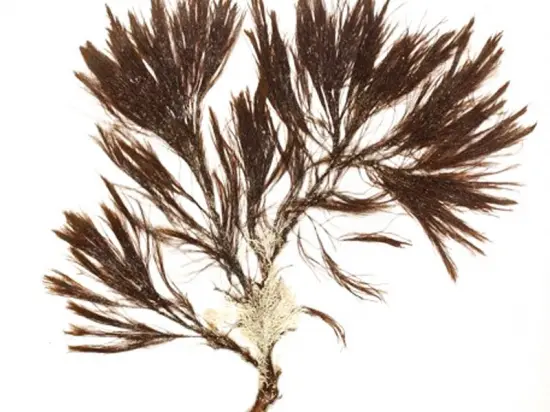
Halopteris scoparia
- Antioxidant[3, 4, 6]
- Antifungal[4, 6]
- Antimicrobial[4, 5, 6]
On Demand weeks

Introduction: Halopteris scoparia
What is Halopteris scoparia?
Halopteris scoparia is a species of red algae (Rhodophyta) that is commonly found in the intertidal and subtidal zones of rocky shores in temperate regions around the world, including Europe, North America, and South America. It is also known by the common name "feather boa kelp" due to its feathery appearance and flexible, ribbon-like branches.
Halopteris scoparia can grow up to 50 centimeters in length and has flattened, fan-shaped branches that are typically divided into numerous finger-like projections. The color of the algae can vary from pink to purple-red, depending on the intensity of light and other environmental factors.
Where does Halopteris scoparia occur?
Halopteris scoparia is commonly found in the intertidal and subtidal zones of rocky shores, as well as in estuaries and coastal lagoons. Halopteris scoparia has been reported in various regions, including Europe, North America, South America, Africa, Asia, and Australia.
In Europe, Halopteris scoparia is found along the Atlantic coast from Norway to Portugal, as well as in the Mediterranean Sea. In North America, it is found along the Atlantic coast from Newfoundland to North Carolina, as well as in the Pacific Northwest from Alaska to California. In South America, it occurs along the coasts of Chile, Argentina, and Uruguay. In Africa, it is found along the coasts of South Africa and Namibia. In Asia, it has been reported in Japan, China, Korea, and Russia.
What can Halopteris scoparia be used for?
Halopteris scoparia has been used for various purposes, including in traditional medicine, as a food source, and in the production of natural products.
In traditional medicine, Halopteris scoparia has been used for its potential therapeutic properties. It contains a variety of bioactive compounds, including polysaccharides, terpenoids, and flavonoids. It has been used to treat various ailments[4].
Halopteris scoparia is also used as a food source, particularly in some Asian countries, where it is consumed as a vegetable or used in soups and stews. It is rich in vitamins, minerals, and dietary fiber and has a mild, slightly sweet flavor.
In addition, Halopteris scoparia has been investigated for its potential use in the production of natural products. Its bioactive compounds have been found to have various applications, including in the cosmetic industry as moisturizers and anti-aging agents, and in the pharmaceutical industry as potential drug candidates for the treatment of various diseases[4].
Typical applications: Halopteris scoparia
Typical applications
The macroalga Halopteris scoparia belongs to the brown algae and is widely distributed in Atlantic and Mediterranean waters.
Due to its active ingredients, Halopteris scoparia is particularly interesting for use in cosmetics and pharmaceuticals. The macroalga Halopteris scoparia contains antioxidants and also has antifungal, and antimicrobial effects[3, 4, 5, 6].
Due to its seasonality, the macroalga Halopteris scoparia is usually abundantly available from September to January.
This product is available in the form of Halopteris scoparia dried raw algae.
Typical applications in the cosmetics industry:
Halopteris scoparia has antibacterial properties. The extract of Halopteris scoparia shows good activity against Propionibacterium acnes, Staphylococcus aureus, Bacillus subtilis and Escherichia coli and thus has the potential to be used as a supporting ingredient for preservation in cosmetics[5].
Halopteris scoparia can help keep skin in good condition through its versatile profile of nutrients and active ingredients[4].
Sources:
- Halopteris scoparia - M.D. Guiry in Guiry, M.D. & Guiry, G.M. 03 October 2024. AlgaeBase. World-wide electronic publication, National University of Ireland, Galway. (https://www.algaebase.org/search/species/detail/?species_id=12624)
- Halopteris scoparia - Wikispecies (https://species.wikimedia.org/wiki/Halopteris_scoparia)
- Güner A, Nalbantsoy A, Sukatar A, Karabay Yavaşoğlu NÜ. Apoptosis-inducing activities of Halopteris scoparia L. Sauvageau (Brown algae) on cancer cells and its biosafety and antioxidant properties. Cytotechnology. 2019 Jun;71(3):687-704. doi: 10.1007/s10616-019-00314-5. Epub 2019 Apr 9. PMID: 30969390; PMCID: PMC6546795. (https://pubmed.ncbi.nlm.nih.gov/30969390/)
- Aalilou Y, Moussa H, Lee LH, Bouyahya A, Zengin G, Faouzi MEA. What hidden treasure resides beneath the waves?: Phytochemistry, pharmacological properties and uses of Halopteris scoparia (Linnaeus) Sauvageau 1904: An overview. Fitoterapia. 2024 Jul;176:106016. doi: 10.1016/j.fitote.2024.106016. Epub 2024 May 11. PMID: 38740345. (https://pubmed.ncbi.nlm.nih.gov/38740345/)
- Shin, Soo. (2021). Antimicrobial, Antioxidative, Elastase and Tyrosinase Inhibitory Effect of Supercritical and Hydrothermal Halopteris scoparia Extract. Turkish Journal of Computer and Mathematics Education (TURCOMAT). 12. 407-413. 10.17762/turcomat.v12i5.976. (https://www.researchgate.net/publication/350864427)
- Čagalj, Martina & Radman, Sanja & Šimat, Vida & Jerkovic, Igor. (2022). Detailed Chemical Prospecting of Volatile Organic Compounds Variations from Adriatic Macroalga Halopteris scoparia. Molecules (Basel, Switzerland). 27. 10.3390/molecules27154997. (https://www.researchgate.net/publication/362678665)

ALGANEX certificate system
Reply within twelve hours